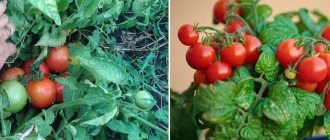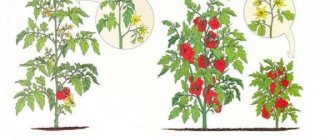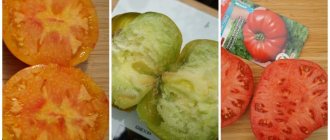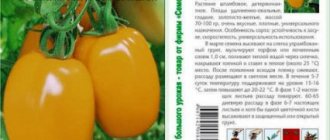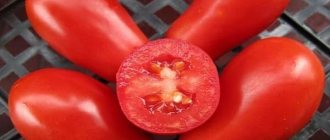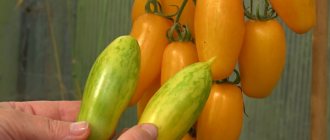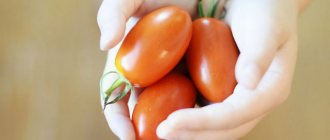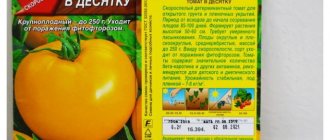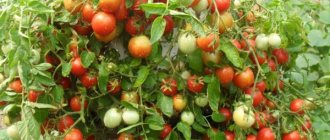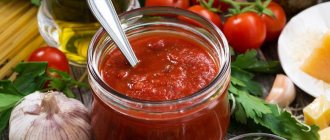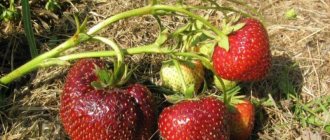The best varieties for Siberia for greenhouses
Most gardeners in Siberia have greenhouses on their plots, most of which are dedicated to planting tomatoes.
Early
Below are the best varieties of tomatoes for growing in Siberian greenhouses with early ripening.
Wonderful lady
Early ripening hybrid - fruiting begins 95 days after emergence. The bush is medium-sized, weakly leafy. The harvest yield is friendly. The fruits have a bright red color, excellent taste and an average weight of 150...200 g. The hybrid is valued for its special resistance to unfavorable growing conditions. Gives consistently high yields even in not the most successful years.
Reviews:
Albina: “I am very grateful to my relatives for advising me to imprison the Beautiful Lady. Despite the early ripening period, the tomatoes are very tasty. They make excellent juices."
Lelya
The hybrid has a mid-early ripening period and enters the fruiting stage 100 days after emergence. The bush is semi-determinate, compact. The foliage is low and the branching is weak, so the plants bear fruit well even in conditions of lack of light. The fruits have a flat-round shape, dense flesh and a bright red color. The weight of the fetus is in the range of 100...150 g.
Tomatoes are universally used: suitable for fresh consumption and processing. The hybrid is characterized by increased resistance to unfavorable growing conditions.
Reviews:
Natasha: “Lelya tomatoes are extremely difficult to germinate compared to other varieties.”
Bulat
The hybrid belongs to the ultra-early determinants; the first harvest can be harvested within 79...85 days from the moment of seed germination. The bush does not exceed 90 cm in height and is characterized by medium foliage. Bulat fruits weigh no more than 120 g each, have a round shape, and a rich red color. The pulp is dense, juicy, of good taste.
The main advantages of the hybrid are resistance to a range of crop diseases, lack of tendency to cracking, and high yield - 15 kg/m2.
Reviews:
Liana: “Tomatoes grow very tasty even in rainy, cool summers. Damask steel has become one of my favorites; I grow it every year by seedlings, as there are concerns about return frosts after planting.”
Ground Gribovsky
An early variety of tomatoes that produces the first fruits within 95...105 days after germination. The semi-spreading bush does not exceed 60 cm in height. The yield of fruits is friendly - a third of the total harvest is harvested in the first 2 weeks from the beginning of fruiting.
Productivity in closed ground conditions is much higher than in open ground, reaching 8 kg/m2. The rounded red fruits are small in size, their weight ranges from 60...100 g. The taste and marketing qualities are good, intended for fresh consumption.
Reviews:
Alina: “The Gribovsky soil is a real godsend for gardeners who do not have the opportunity to constantly be on the site during the season. There is no need to tie him up or pin him down. The yield is stable even in short, cool summers."
The most productive
Productivity is one of the most important criteria for a gardener, which significantly influences the choice of variety for the greenhouse. In the protected soil of Siberia, you can harvest large harvests of tomatoes, the main thing is to choose the right variety.
Scarlet candles
The Scarlet Candles tomato has an average ripening period, although manufacturers often indicate this indicator as mid-early. The bush is heavily leafy and tall, with an extended fruiting period. The fruits are medium-sized – 100...130 g, elongated in shape with a sharp tip. The taste characteristics are excellent, small tomatoes have a sweet, sugary taste. The flesh is fleshy and dense. The skin is dense and smooth. Productivity – 12…15 kg/m2.
Reviews:
Lyubov: “Scarlet candles are planted in the greenhouse according to a thickened planting pattern every 25 cm. The bushes are tied with 10...11 fruit clusters, regardless of weather conditions. I use the harvest in salads and pickling."
Samokhval
Tomato Samokhval belongs to the yellow-fruited varieties of the crop. Heart-shaped tomatoes with a yellow color have a high carotene content. The weight of the fruit depends on the degree of care for the bushes: with normal care, the fruits weigh 200 g, if all the rules of agricultural technology are followed - 800 g. The pulp is yellow, sugary, and very tasty. Bushes of medium height, medium foliage, with strong branching. Productivity – at least 5 kg/bush.
Reviews:
Tatyana: “I planted Samokhval for the first time in 2015. For the last few years I have been trying to find seeds of this variety, but they are not available for retail sale. I'll have to order from collectors."
Bull forehead
The mid-early variety, bred by Siberian breeders, belongs to the indeterminate variety. During the season, not only the stems are tied up, but also the fruit branches, which can break under the weight of large tomatoes. The weight of one of them is 600 g; the first tomatoes ripen the largest. The shape of the fruit is round, the color is bright red. The pulp is very tasty, sugary with a subtle sourness, meaty. There are few seeds. Productivity – 9 kg/bush or 17…18 kg/m2.
Reviews:
Maria: “I don’t have much experience in gardening, but that didn’t stop me from growing large, tasty tomatoes in the greenhouse. Bull's forehead did not give special care to tomatoes, but the yield was high. Next year I’ll definitely plant it again and collect the seeds myself.”
Siberian surprise
A hybrid with a medium-early ripening period (100-110 days) bears fruit in small pepper-shaped tomatoes. The average fruit weight is 150 g. The color is bright red, rich. The pulp is juicy, dense, with a classic tomato taste and aroma.
The bush is indeterminate, heavily leafy, so it is thinned out as it grows. It is highly resistant to diseases and unfavorable conditions, and has a high yield of 9 kg/bush.
Reviews:
Natalya: “The recommended growing scheme for Siberian surprise is 2 stems. I grew them in 1 stem, so the fruits turned out to be somewhat larger and were no longer suitable for pickling. But the juice they made was simply excellent.”
short
Low-growing varieties and hybrids of tomatoes allow the crop to be grown in low greenhouses, and therefore are in demand among Siberian gardeners.
Budenovka
The Budenovka variety can give a head start to any new hybrid: it is highly resistant to diseases and stress under unfavorable growing conditions. It bears fruit in an average period - 110 days from the moment of germination. The fruits, in their characteristics, are very similar to Bull's Heart tomatoes - also heart-shaped, pink, large. The weight of one of them is 300...800 g. The skin is thin, but dense.
Tomatoes of the Budenovka variety are perfectly stored and transported. The bush is determinate, about 120 cm high, with few leaves. The rhizome is powerful, the stem is thin, so it needs to be tied up. Productivity – 7 kg/bush.
Reviews:
Tatyana: “In the 2021 season, I grew pink and red Budenovka. The pink one was larger-fruited, but the number of fruits was smaller compared to the red variety. Both varieties took a long time to bear fruit, so they had to be removed and stored for ripening. Keeping quality is excellent"
The Velvet season
The bushes of the variety are determinate, do not exceed 70 cm in height. The fruits are round, slightly elongated downwards. The taste is very sweet, sugary. The flesh is fleshy and dense. The skin is dense and protects the fruit from cracking. The purpose of the fruits is universal: they are used for pickling and salads; juice is not obtained from them. The average fruit weight is 100 g, however, tomatoes weighing up to 300 g are often found. The fruits are well stored.
Reviews:
Olga: “The variety showed its power already at the very early stages of development - the seedlings entered together, the seedlings grew very strong and healthy. When planted in a permanent place, there were no problems with survival. The yield of the Velvet Season bushes was also pleasantly pleasing."
Olya
The hybrid is determinate, grows in a greenhouse no more than 120 cm in height. With low growth, up to 15 fruit clusters are formed on the bush. The fruits ripen 90...105 days after emergence. The round, bright red fruits are small in size, with an average weight of 120...150 g. The pulp is fleshy and has good taste, despite the early ripening period.
The purpose is universal: the fruits are suitable for preparations and salads. The main advantages of the hybrid are high yield, resistance to stress and high immunity to many diseases and some crop pests.
Reviews:
Tatyana: “The tomatoes are small, but very tasty, the yield is amazing. There is little foliage on the bush, the shoots branch weakly, no pinching is required.”
Pink honey
Determinate bush, limited in growth to 1.5 m in greenhouse conditions. Ripening dates are mid-early. The fruits are large, fleshy, juicy, sweet. The weight of one of them is in the range of 300...600 g; by normalizing the number of ovaries, you can grow fruits weighing 1 kg. They are used fresh or for juice production. Disadvantages of the variety: average resistance to diseases and short shelf life.
Reviews:
Asel: “A super variety, they are planted annually in a polycarbonate greenhouse. It bears fruit until the cold weather, the tomatoes are very tasty."
Large-fruited
Many gardeners love to grow large salad tomatoes, which have a sugary, sweet taste.
Alsou
This variety is one of the most beloved among Siberian summer residents. The growth of the bush is limited and can reach 1...1.5 m. In greenhouse conditions, its stem is formed thin, so Alsou needs to be tied up. The first fruits ripen weighing from 600 g to 1 kg; in the upper ovaries the size becomes smaller, but still exceeds the average.
The taste of tomatoes is excellent, sweet. The pulp is juicy and sugary. The thin but dense skin reliably protects the fruit from cracking, ensures good shelf life and transportation without loss of quality. The shape of the fruit is heart-shaped. The yield is high, 7...9 kg can be harvested from one bush.
Reviews:
Valery: “An excellent variety, from which I have been collecting seeds myself for the last 2 seasons, and there is practically no difference compared to purchased material. At the end of September, the plants are affected by late blight, but the fruits are resistant to it. I think the only drawback is the presence of white veins in the pulp of some fruits, but it seems to me that the situation can be corrected with more careful care."
Abakan pink
The variety is indeterminate with an average fruiting period. The fruits are reminiscent of Bull's Heart tomatoes: bright pink, heart-shaped. The pulp is fleshy, sweet with sourness. The weight of the fruit is in the range of 200...500 g. It is distinguished by good yield and high quality of fruit.
Reviews:
Nadezhda: “Every year I grow Abakan pink in a greenhouse - the tomatoes are very large, up to 700 g, tasty, great for early summer salads. One year the bushes were affected by blossom end rot, but timely measures taken made it possible to save most of the harvest."
King of Siberia
The variety is indeterminate and begins to bear fruit in the middle period. Can be formed into 1…2 stems. The fruits are yellow-orange, heart-shaped. The flesh is fleshy and very sweet. On the lower tiers of bushes, tomatoes ripen very large - up to 600 g, on the higher ones - 300...350 g each. Productivity is average - up to 4.5 kg / bush with careful care.
Reviews:
Tatyana: “I have been growing the King of Siberia variety in a greenhouse for many years and am satisfied with the harvest even in the coldest rainy summer. The variety is unpretentious, reliable"
Grandma's secret
The bush is indeterminate and enters the fruiting phase in the middle period. Gartering and pinching are required. The fruits are large, weighing from 300 to 600 g, sometimes there are specimens weighing 1000 g. The pulp is fleshy, juicy, very sweet. The fruits can be used in salads and for making juices. The shape is flat-round. Productivity – more than 5 kg/bush.
Reviews:
Irina: “I grew bushes with 3 trunks, the fruits varied in weight: from 250 to 600. The average yield per bush was 7.1 kg (19 pieces). The fruits are very tasty with fleshy pulp."
Resistant to late blight
Late blight is a dangerous disease that occurs in the second half of summer. Many new varieties and hybrids of tomatoes are resistant to it.
Kostroma
The first fruits from indeterminate bushes of the hybrid can be collected within 103...108 days after emergence. The fruits are smooth, flat-round, colored in an intense red color.
Their size is small, on average 90...150 g. 6...9 pieces ripen in one brush. The taste is excellent - the pulp has a dessert taste. Product characteristics are high. The average yield of the hybrid is 4.5...5 kg/bush. High resistance to major crop diseases.
Reviews:
Lyudmila: “I really liked the hybrid, the taste was really dessert-like, which is quite strange, because tomato hybrids usually have a weak taste. During the season, the bushes did not get sick, even despite the fact that cladosporiosis was noticed on the site."
Kohawa
Hybrid indeterminate with early ripening. It has an extended fruiting period and produces tomatoes until late autumn. The fruits are flat-round, red-pink. The average weight of the fruit is 150 g. Its purpose is universal: it can be used fresh or for preservation. Commercial quality is high: tomatoes are well stored and transported. Resistance to late blight and other diseases is high.
Reviews:
Igor: “When growing Kokhava in a greenhouse, I got my first tomatoes within 70 days. The neighbors didn't believe it until they checked it. The bush grows large and powerful, performs well in unfavorable growing conditions - with infrequent watering, it bears fruit consistently. The yield is very high, and does not get sick during the season.”
Titanic
A determinant hybrid, its height does not exceed 60 cm. It bears fruit in the mid-early period, 110 days after germination. The tomatoes ripen evenly and have excellent commercial characteristics. They tolerate transportation well and are stored for a long time. The color of the fruit is dark red, round in shape. The average weight of the fruit is 120...140 g. Individual specimens can reach 250 g. The taste is sweet and sour, classic. Productivity is high - 5...7 kg/bush.
Reviews:
Veronica: “I planted Titanic in a greenhouse, and my friend grew it on the balcony. The result is excellent with regular feeding and ventilation."
Bersola
Early semi-determinate hybrid. The bush is compact. Fruit set is excellent. The hybrid is highly resistant to stress and disease. The fruits are round, bright red, smooth. The average weight of one of them is 160 g. Taste and commercial qualities are high. The new hybrid of Dutch selection has not yet been tested by a large number of Russian gardeners.
Cherry
Growing cherry tomatoes allows you not only to get a lot of small, tasty tomatoes suitable for fresh consumption and for use in preparations, but also to decorate your plot. Many cherry varieties are very decorative, differing in the color of the fruit and their shape.
Graph
An early indeterminate hybrid with weak foliage. Fruits weighing 40...50 g, red in color, plum-shaped. The thin, dense skin prevents cracking. High-yielding hybrid. Taste qualities are high.
Mila
The bushes are indeterminate and enter the fruiting phase early. The fruits are small, up to 15 g. Orange in color, cylindrical in shape. When fully ripe, the fruits do not fall off the branches. The pulp is orange, the taste is dessert.
Alina
The indeterminate tomato bears pink cherry tomatoes with an average weight of 20 g. The fruits are smooth, elongated, plum-shaped.
Atom
Early ripening indeterminate, producing round cherry tomatoes. The average weight of one of them is 40...50 g. The color of the tomatoes is red. The harvest yield is friendly. Increased resistance to stress.
For pickling
Homemade pickles are an invariable decoration of the festive and everyday table, which is why many gardeners grow varieties of tomatoes suitable for pickling.
Greek
The bush is tall, grows up to 180 cm. The hybrid is high-yielding and early ripening. The fruits are small, weighing 120...150 g. The shape is elongated, with a spout, the color is crimson. The pulp is very tasty and juicy. Greek grass is resistant to a complex of cultural diseases. Valued for its high taste and commercial qualities.
Margarita: “Ideal for pickling and juices”
Olesya
The Olesya variety is a yellow-fruited tomato. The bushes are indeterminate and require pinching and support. The fruits are elongated, plum-shaped, weighing 150...300 g. The pulp is sweet and fleshy. The manufacturer warns about the possibility of fruit cracking during preservation, but judging by reviews from gardeners, the information has not been confirmed in practice.
Reviews:
Galina: “I’ve been planting Olesya in a greenhouse for several seasons in a row. The yield is average, but the tomatoes are very tasty, and this fact outweighs all the disadvantages."
Koenigsberg
The bushes of the variety are indeterminate and have medium ripening periods. The fruits are red, cylindrical, weighing 150...300 g. The pulp is very tasty and sweet. The average yield is 20 kg/m2. The fruits are well stored.
Reviews:
Natalya V: “Despite the low yield this season, I really liked the variety - the fruits are tasty, very good for pickling.”
Sabelka
The Sabelka tomato bears fruit in the mid-late period, approximately 120 days after emergence. The fruits have a very unusual shape - long, elongated. The weight of one of them is 100...120 g. The pulp is dense, meaty, tasty. Used fresh and for whole-fruit canning. Productivity – up to 7 kg/m2.
Reviews:
Alexandra: “A super variety that has surpassed all previously grown long-fruited tomato varieties.”
Tomatoes in Siberia. Varieties grown in a greenhouse: video
What is the best way to sow tomatoes for seedlings in Siberia, tricks
When the sowing time has come, you can begin directly planting home seedlings. However, before sowing tomato seeds, you need to prepare the soil, pots and other material.
Preparing the soil needed for planting
Soil with a neutral composition and favorable parameters is considered an important condition for the fruitful cultivation of crops. You can buy soil at hardware stores or make it yourself. Experienced summer residents recommend starting to prepare the soil a week before sowing.
IMPORTANT TO REMEMBER! For the seeds of this crop, it is necessary to have specialized soil intended specifically for tomatoes. You can buy this soil in almost every store.
In addition, there are quite popular rumors, which have been confirmed more than once by the positive experience of gardeners: at the time of preparing the soil, it is worth adding soil taken from the garden, into which the seedlings will subsequently grow. This manipulation makes it possible to reduce the stress of the plant during transplantation and will help it quickly adapt to the new soil.
DO NOT FORGET! Before sowing seedlings into the soil, no matter whether purchased or prepared with your own hands, it must be subjected to a disinfection procedure, that is, placed in the oven and heated for 30-40 minutes.
How to choose a suitable container for seedlings
In order for the seedlings to be comfortable and have plenty of free space for development and growth, it is important to choose a suitable pot for it, which will be the “home” for the tomatoes for the next few months. At the gardening store you can find pots of any material and size.
The main thing is to take into account the number of grains sown so that later the seedlings are not crowded.
How to choose seeds for seedlings
When choosing grains for tomato seedlings, do not forget that literally everything depends on the quality of the seeding material: from the health of the tomatoes to a rich and sweet harvest. Experienced gardeners advise purchasing seedlings from reliable manufacturers who produce exceptionally high-quality products.
NOTE! When buying tomato seeds for seedlings, look not only at the manufacturer’s advice and beautiful packaging, but also at the expiration date. Gardeners advise purchasing seed produced no more than two years ago.
In addition, in addition to the option of purchasing seedlings in specialized stores and online markets, grains can be collected and stored for sowing in the future.
The best varieties for Siberia for open ground
In the vast expanses of Siberia, gardeners grow tomatoes not only in greenhouses, but also in open ground. Below is the TOP 10 varieties and hybrids that are the most valuable for summer cottages in Siberia.
Kubyshka
A determinate variety that bears fruit in the middle period. The height of the bush is no more than 70 cm. The fruits are bright red, round, weigh 200 g. The pulp is fleshy, dense, sweet. The variety grows well even in unfavorable conditions and is resistant to most crop diseases.
Reviews:
Vladimir: “The variety is very reliable - it bears fruit well even in rainy, cold summer conditions.”
May early
The variety is ultra-early ripening, the first fruits can be harvested within 80...90 days after germination. Bushes of limited growth, do not exceed 1 m in height. The fruits are medium-sized, 60 g. The yield is average - up to 6 kg/m2. The pulp is sweet, fleshy. Fruits of universal use.
Ultra early ripening
An early ripening ultra-determinate, the height of which does not exceed 0.5 m. The fruits are smooth, round, have an average weight of 100 g. The average yield is 2 kg/bush. The pulp is of good taste. The purpose of the fruit is universal.
Reviews:
Elena: “I don’t pinch the Ultra-early ripening bushes, but I do tie them up - under a large number of fruits the bush begins to bend to the ground.”
Generator
A high-yielding early hybrid that produces small plum-shaped tomatoes. Tomatoes can be eaten fresh or pickled. Their weight is 70...130 g. Resistance to diseases is high. Productivity – 8 kg/m2.
Reviews:
Igor: “I’ve been planting Generator tomatoes for several years now. The hybrid bears fruit consistently regardless of weather conditions."
Countryman
The bushes are limited in growth and do not exceed 75 cm. Small red oblong fruits appear early. The weight of one of them is 60...80 g. The purpose of the fruit is universal. The countryman has a high immunity to major crop diseases. From one bush you can harvest up to 4 kg of tomatoes with a pleasant sweetish taste.
Reviews:
Galina: “Zemlyak is one of my favorites, which is characterized by consistently high yields in any weather. The best option for pickling"
Demidov
A determinate variety that has no hybrid analogues. The bushes have potato foliage, low growth - up to 65 cm, and are characterized by weak branching of shoots. The fruits can weigh from 80 to 120 g. The taste is excellent.
Reviews:
Ivan: “The variety is unpretentious and does not need garters. The taste is excellent, sweet, without wateriness."
White filling
The bush is determinate and enters the fruiting phase 100 days after emergence. The variety is resistant to late blight. From the bush you can collect 3 kg of small red round fruits. The weight of one of them is 80...130 g. The pulp is fleshy, juicy, sweet with sourness. Product quality is high.
Reviews:
Elena: “White filling is an old, proven variety; I like it because it doesn’t have high maintenance requirements.”
Visibly-invisibly
A very productive determinate variety with an early harvest period. The fruits are round, slightly flattened, red in color. The weight of one of them is 280...330 g. The taste characteristics are high. Product quality is excellent. Productivity – up to 5 kg/bush.
Reviews:
Marina: We grew them in open ground, the tomatoes were picked until frost, the yield was simply mind-blowing.”
Oak
An early determinate variety, its bushes do not exceed 70 cm in height. With careful care, you can harvest 5 kg of small tomatoes from a bush. Their weight varies greatly: from 50 to 130 g. The pulp is hard and dry. The purpose of the fruit is universal.
Reviews:
Vanessa: “Planting Oak in open ground and in a greenhouse. In protected soil, tomatoes ripen a little earlier and are larger in size."
Honey saved
Determinate bushes (70...140 cm) bear fruit with bright orange tomatoes collected in clusters. The pulp is very sweet and juicy. Tomatoes are suitable for dietary and baby food. The average fruit weight is 300 g.
Reviews:
Tamara: “The variety is very tasty, large-fruited. But it has its drawbacks, for example, poor resistance to diseases and short shelf life of fruits."
Heavyweights of Siberian selection. Collection varieties of tomatoes: video
When to sow tomatoes for seedlings in Siberia in 2021, planting dates according to the lunar calendar?
Experienced gardeners usually use the lunar calendar as a guide, using it to determine the most successful days for planting tomatoes. It is no secret that lunar phases can favorably influence the growth and development of crops.
The lunar calendar allows gardeners to figure out which day will be the most favorable and safe for planting grains of this crop.
Rating of the best tomato varieties for Siberia for 2021
According to the 2021 season data and reviews from gardeners, the TOP 5 best varieties for Siberia were created.
Gina
Gina is a reliable hybrid that produces crops in all weather conditions. The bush is determinate and does not require pinching or support. The fruits are medium-sized, weighing 150 g, ideal for harvesting and fresh consumption.
Reviews:
Marina: “There are a lot of tomatoes, they are very tasty: there is much more aromatic pulp than seeds and juice.”
Rocket
Rocket is an early ripening, determinate variety for open ground, bearing fruit in medium-sized oblong tomatoes weighing 70 g. Ideal for preservation. The bushes do not require staking or pinching.
Reviews:
Elizaveta: “During heat treatment, the skin of Rocket tomatoes does not burst and is easily removed. The fruits are even and ripen the same size.”
Sweet bunch
Sweet bunch is an early ripening variety that is one of the first to please with its harvest. The fruits are small, but very sweet. Suitable for fresh consumption and preservation.
Reviews:
Irina: “The tomatoes are very tasty, a productive variety. But the fight against stepchildren was waged all summer - they simply grow instantly, and if you forget about stepchildren even for a short time, the greenhouse becomes overgrown with dense forest.”
Naughty
Shalun is an early high-yielding variety with smooth, beautiful fruits that are distinguished by high taste and commercial qualities. Belongs to the new Siberian varieties.
Reviews:
Lily: “An excellent variety, grown in open and protected ground. Showed good results everywhere.”
Stellate sturgeon
Sevruga is a relatively new large-fruited variety, the fruits of which, with proper care, can reach 1.5 kg. Heart-shaped, red in color. The taste is great, sugary. From one bush you can get 5 kg of delicious tomatoes.
Reviews:
Zalida: “The variety is very good, despite the low growth of the bush, the tomatoes are large and tasty. Not sick at all.”
What varieties of tomatoes are good for open ground in Siberia: video
Choosing a suitable variety of tomato seeds for growing in Siberia is a responsible matter. The final result depends on the right choice.
Favorable time for planting tomatoes in 2021 according to the lunar calendar in Siberia
You can plant tomatoes from February until the end of April, however, you need to choose more favorable days for this, relying on the phases of the lunar calendar.
So, the best days this year for planting tomatoes are:
- February: from 12 to 26.
- March: from 14 to 27.
- April: from 13 to 26.
- May: from 12 to 25.
On other days, summer residents can safely prepare the soil for planting tomatoes.
Soil preparation
Cultivation of soil for planting tomatoes begins in the fall. During this period, you need to remove the remains of the previous crop and carefully dig up the soil. Planting can be done in places where zucchini, cucumbers, beets, corn, carrots, and legumes previously grew.
Tomatoes prefer neutral soil, which has good moisture and air permeability. Compost, ash, and humus must be added to the soil.
Advice! The bed with tomatoes is located in a sunny area where there is no shade.
Plantings should not be exposed to excessive moisture. Otherwise, plant development will slow down and fungal diseases will appear.
In spring, mineral fertilizers are applied to the soil to a depth of 20 cm. It is recommended to use up to 10 g of urea, 50 g of superphosphate and 15 g of potassium chloride per square meter of beds.
For planting tomatoes, the beds are located from north to south. At least 1 m is left between the beds, and up to 0.7 m between the rows. Sides up to 5 cm high must be made. The beds can be divided into sections up to 0.5 m, in each of which two bushes of plants are planted.
Rules of care
Proper care of tomatoes allows you to get a good harvest in the Siberian climate. Plants require regular watering, mulching or loosening the soil. The supply of nutrients is ensured by feeding tomatoes. Particular attention is paid to protective measures aimed at combating diseases and pests.
Organization of watering
When growing tomatoes, you need to ensure a moderate supply of moisture. Its excess negatively affects the development of plants and provokes the spread of diseases.
Tomatoes can tolerate short-term drought. In such a situation, moisture is introduced constantly, but in small parts. With intensive watering, cracking of the fruits will occur.
Advice! When watering, water should not fall on the foliage and flowers of plants.
It is not recommended to water the plantings with cold water from a hose. It is better to fill the containers with water in advance and leave them to warm up in the sun. If necessary, add warm water to them. Watering the plants is carried out in the morning or evening.
In open ground, tomatoes are watered after the moisture has been completely absorbed. Do not allow the soil to dry out. The frequency of watering is adjusted taking into account precipitation. On average, tomatoes are watered once a week.
Low-growing plants need 2-3 liters of water, while tall tomatoes may require up to 10 liters. It is not recommended to water the plants for the first 2 weeks after planting.
Important! When the first fruits appear, the tomatoes' need for moisture increases, so the plants are watered more often.
In a large area, you can install drip irrigation. For this purpose, a piping system is used to ensure a uniform supply of moisture to the plants. The drip system allows you to monitor water consumption for tomatoes.
Loosening or mulching
After each watering, the soil is loosened. The procedure helps warm the soil, improves the penetration of moisture and nutrients. This removes weeds that interfere with the normal development of tomatoes.
The first loosening is carried out immediately after planting the tomatoes. Then the procedure is repeated every 2 weeks. The depth of soil loosening is up to 3 cm.
Together with loosening, you can hill up tomatoes. Hilling up promotes the growth of the plant root system and strengthens the plantings.
Mulching consists of creating a protective layer above the soil surface. This procedure increases productivity, accelerates fruit ripening, and protects the root system of tomatoes from moisture loss. Mulched soil does not require loosening and weeding.
Advice! For tomatoes, mulch of straw or compost is chosen.
The organic layer retains heat and moisture for the plants, providing additional nutrition for the tomatoes. For these purposes, mowed grass that is thoroughly dried is suitable. Periodically, the mulch layer will rot, so it needs to be updated.
Fertilizer application
Regular feeding provides tomatoes with useful substances responsible for the growth of green mass, the formation of ovaries and fruits.
Tomatoes require fertilizer at the following stages of development:
- after planting;
- before flowering begins;
- when the ovary appears;
- during the process of fruit ripening.
The first fertilizing is carried out two weeks after transferring the plants to open ground. A solution is prepared for it, consisting of superphosphate (40 g) and potassium sulfate (10 g). The components are dissolved in 10 liters of water, after which the tomatoes are watered at the root.
The treatment is repeated until inflorescences appear on the plants. When the tomatoes begin to set, you can prepare a yeast supplement. To do this you will need 10 g of dry yeast and 1 tbsp. l. sugars, which are mixed and left for several hours. Then water is added to the resulting mixture in a ratio of 1:10 and the plants are watered.
During the fruiting period, solutions containing phosphorus are prepared. For 5 liters of water you will need 1 tbsp. l. superphosphate and liquid sodium humate.
You can feed tomatoes with an ash-based solution. A bucket of water will require 0.2 kg of wood ash. The solution is infused for 5 hours, after which it is filtered and diluted with water in a ratio of 1:3. The resulting product is watered at the roots of the plants.
Foliar treatment
Foliar feeding will help speed up the supply of nutrients. Mineral and organic substances are used for its preparation.
During the flowering period, tomatoes are sprayed with a solution containing boric acid. Take 1 g of boric acid per liter of water.
Important! Spraying of plants is carried out in cloudy weather, when there is no direct exposure to the sun.
Another spraying method is to use superphosphate. For 1 liter of water, 2 tbsp is required. l. of this substance. The product is infused for 10 hours, after which it is diluted with water in a ratio of 1:10.
Between treatments take a break of up to 10 days. Foliar treatment should be alternated with root application of fertilizers.
Protection from diseases and pests
Violation of the rules for planting and caring for tomatoes contributes to the development of diseases and the appearance of pests. The following rules will help protect plants in Siberia in greenhouses and open ground:
- avoid dense plantings;
- compliance with crop rotation;
- timely watering and fertilization;
- preventive treatment.
Tomatoes are susceptible to late blight, powdery mildew, brown and white spot. Most diseases are spread by fungi in high humidity environments.
When the first symptoms appear, the plants are treated with fungicides: “Fitosporin”, “Quadris”, “Ridomil”, “Bravo”. In rainy summers, it is recommended to treat plantings every two weeks for preventive purposes.
Advice! The use of drugs is stopped 14 days before harvest.
To prevent tomato diseases, you can use traditional methods. One of them is spraying plants with a solution containing 1 liter of milk, 15 drops of iodine and a bucket of water. The product prevents the penetration of harmful microbes into plant tissue.
The greatest damage to plantings is caused by aphids, whiteflies, mole crickets, and spider mites. To protect against insects, insecticides are used - “Zolon”, “Sherpa”, “Konfidor”.
Folk remedies are actively used to combat insects. Between the rows of tomatoes, you can sprinkle a little wood ash, which additionally supplies the plants with useful minerals. Between the rows of tomatoes you can plant onions and garlic, which repel pests.
Varieties of yellow tomatoes for any region
In the State Register you can find yellow varieties recommended for cultivation in any region. They are grown in the garden and in greenhouse conditions.
Duckling
Advantages of the variety: taste, resistance to rot (apex, root), high setting. It does not depend on the weather. There is one minus – low yield (2.2 kg/m²). The fruits (60 g) are used for preparing salads and canning. They ripen early and together. The bushes are standard, determinate type, and do not require much care.
Cherry yellow
Advantages of the variety: early ripening (92-96 days), seasoned, harmonious taste, brushes can be preserved. Disadvantage – susceptible to fusarium, cladosporiosis and TMV. Grown in open ground. The variety is popular among small farmers.
From 30 to 50 small (20 g) round tomatoes are formed in a brush. The bushes are indeterminate (1.5 m), require staking and shaping. The yield of one plant is 1 kg. Ripe tomatoes can hang on the bushes for a long time. The seeds can be used to grow seedlings.
